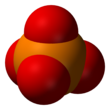Aluminium phosphate

| |||
| |||
| Names | |||
|---|---|---|---|
| Other names
Aluminum phosphate
Aluminium monophosphate Phosphoric acid, aluminium salt (1:1) | |||
| Identifiers | |||
| |||
3D model (
JSmol ) |
|||
| ChEMBL | |||
| ChemSpider | |||
| DrugBank | |||
ECHA InfoCard
|
100.029.142 | ||
| EC Number |
| ||
PubChem CID
|
|||
RTECS number
|
| ||
| UNII | |||
| UN number | 1760 | ||
CompTox Dashboard (EPA)
|
|||
| |||
| |||
| Properties | |||
| AlPO4 | |||
| Molar mass | 121.9529 g/mol | ||
| Appearance | White, crystalline powder | ||
| Density | 2.566 g/cm3, solid | ||
| Melting point | 1,800 °C (3,270 °F; 2,070 K) | ||
| Boiling point | Decomposes | ||
| 1.89×10−9 g/100 ml[1] | |||
Solubility product (Ksp)
|
9.84×10−21[1] | ||
| Solubility | Very slightly soluble in HCl and HNO3 | ||
Refractive index (nD)
|
1.546 [2] | ||
| Pharmacology | |||
| A02AB03 (WHO) | |||
| Hazards | |||
| GHS labelling: | |||
 
| |||
| Warning | |||
| H314, H315, H319, H332, H335 | |||
| P260, P261, P264, P271, P280, P301+P330+P331, P302+P352, P303+P361+P353, P304+P312, P304+P340, P305+P351+P338, P310, P312, P321, P332+P313, P337+P313, P362, P363, P403+P233, P405, P501 | |||
| NFPA 704 (fire diamond) | |||
| Lethal dose or concentration (LD, LC): | |||
LD50 (median dose)
|
4640 mg/kg (rat, oral) > 4640 mg/kg (rabbit, dermal) | ||
Except where otherwise noted, data are given for materials in their standard state (at 25 °C [77 °F], 100 kPa).
| |||
Aluminium phosphate is a
Berlinite
AlPO4 is
Uses
Molecular sieves
There are many types of aluminium phosphate molecular sieves, generically known as "ALPOs". The first ones were reported in 1982.[8] They all share the same chemical composition of AlPO4 and have framework structures with microporous cavities. The frameworks are made up of alternating AlO4 and PO4 tetrahedra. The denser cavity-less crystalline berlinite, shares the same alternating AlO4 and PO4 tetrahedra.[7] The aluminophosphate framework structures vary one from another in the orientation of the AlO4 tetrahedra and PO4 tetrahedra to form different-sized cavities, and in this respect they are similar to the aluminosilicate zeolites, which differ in having electrically charged frameworks. A typical preparation of an aluminophosphate involves the hydrothermal reaction of phosphoric acid and aluminium in the form of hydroxide, an aluminium salt such as aluminium nitrate salt or alkoxide under controlled pH in the presence of organic amines.[9] These organic molecules act as templates (now termed structure directing agents, SDAs) to direct the growth of the porous framework.[10]
Other
Along with aluminium hydroxide, aluminium phosphate is one of the most common immunologic adjuvants (efficiency enhancers) in vaccinations. Aluminium adjuvant use is widespread due to its cheap price, long history of use, safety and efficiency with most antigens.
Similar to aluminium hydroxide, AlPO4 is used as an
Additional uses for AlPO4 in combination with or without other compounds are white colorants for pigments, corrosion inhibitors, cements and dental cements. Related compounds have also similar uses. For example, Al(H2PO4)3 is used in dental cements, metal coatings, glaze compositions and refractory binders; and Al(H2PO4)(HPO4) is used cement and refractory binders and adhesives.[13]
Related compounds
AlPO4·2H2O dihydrate is found as the minerals
A synthetic hydrated form, AlPO4·1.5H2O is also known.[15]
See also
- Phosphate minerals
References
- DEC, Corbridge. (2013). Phosphorus: chemistry, biochemistry and technology (6th ed.). CRC Press. ISBN 9781439840894.
Citations
- ^ ISBN 978-1138561632.
- ISBN 0-07-049439-8
- ^ a b Corbridge, p. 207-208
- ^ Corbridge, p. 310
- ISSN 1098-0121.
- ^ Crystal growth of an α-quartz like piezoelectric material, berlinite, Motchany A. I., Chvanski P. P., Annales de Chimie Science des Materiaux properties, 2001, 26, 199
- ^ ISBN 978-0-08-037941-8.
- ISSN 0002-7863.
- ISBN 9783527325054.
- ISBN 9780470822333.
- ^ ISBN 9780124080782.
- PMID 30252305, retrieved 2019-02-28
- ^ Corbridge, p. 1025
- ISSN 1528-7483.
- ISSN 0888-5885.



